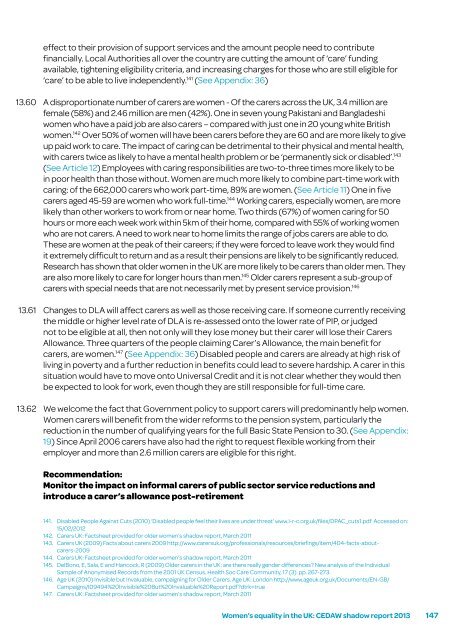Women’s equality in the UK – A health check
Women’s equality in the UK – A health check
Women’s equality in the UK – A health check
You also want an ePaper? Increase the reach of your titles
YUMPU automatically turns print PDFs into web optimized ePapers that Google loves.
13.60<br />
13.61<br />
13.62<br />
effect to <strong>the</strong>ir provision of support services and <strong>the</strong> amount people need to contribute<br />
f<strong>in</strong>ancially. Local Authorities all over <strong>the</strong> country are cutt<strong>in</strong>g <strong>the</strong> amount of ‘care’ fund<strong>in</strong>g<br />
available, tighten<strong>in</strong>g eligibility criteria, and <strong>in</strong>creas<strong>in</strong>g charges for those who are still eligible for<br />
‘care’ to be able to live <strong>in</strong>dependently. 141 (See Appendix: 36)<br />
A disproportionate number of carers are women - Of <strong>the</strong> carers across <strong>the</strong> <strong>UK</strong>, 3.4 million are<br />
female (58%) and 2.46 million are men (42%). One <strong>in</strong> seven young Pakistani and Bangladeshi<br />
women who have a paid job are also carers <strong>–</strong> compared with just one <strong>in</strong> 20 young white British<br />
women. 142 Over 50% of women will have been carers before <strong>the</strong>y are 60 and are more likely to give<br />
up paid work to care. The impact of car<strong>in</strong>g can be detrimental to <strong>the</strong>ir physical and mental <strong>health</strong>,<br />
with carers twice as likely to have a mental <strong>health</strong> problem or be ‘permanently sick or disabled’. 143<br />
(See Article 12) Employees with car<strong>in</strong>g responsibilities are two-to-three times more likely to be<br />
<strong>in</strong> poor <strong>health</strong> than those without. Women are much more likely to comb<strong>in</strong>e part-time work with<br />
car<strong>in</strong>g: of <strong>the</strong> 662,000 carers who work part-time, 89% are women. (See Article 11) One <strong>in</strong> five<br />
carers aged 45-59 are women who work full-time. 144 Work<strong>in</strong>g carers, especially women, are more<br />
likely than o<strong>the</strong>r workers to work from or near home. Two thirds (67%) of women car<strong>in</strong>g for 50<br />
hours or more each week work with<strong>in</strong> 5km of <strong>the</strong>ir home, compared with 55% of work<strong>in</strong>g women<br />
who are not carers. A need to work near to home limits <strong>the</strong> range of jobs carers are able to do.<br />
These are women at <strong>the</strong> peak of <strong>the</strong>ir careers; if <strong>the</strong>y were forced to leave work <strong>the</strong>y would f<strong>in</strong>d<br />
it extremely difficult to return and as a result <strong>the</strong>ir pensions are likely to be significantly reduced.<br />
Research has shown that older women <strong>in</strong> <strong>the</strong> <strong>UK</strong> are more likely to be carers than older men. They<br />
are also more likely to care for longer hours than men. 145 Older carers represent a sub-group of<br />
carers with special needs that are not necessarily met by present service provision. 146<br />
Changes to DLA will affect carers as well as those receiv<strong>in</strong>g care. If someone currently receiv<strong>in</strong>g<br />
<strong>the</strong> middle or higher level rate of DLA is re-assessed onto <strong>the</strong> lower rate of PIP, or judged<br />
not to be eligible at all, <strong>the</strong>n not only will <strong>the</strong>y lose money but <strong>the</strong>ir carer will lose <strong>the</strong>ir Carers<br />
Allowance. Three quarters of <strong>the</strong> people claim<strong>in</strong>g Carer’s Allowance, <strong>the</strong> ma<strong>in</strong> benefit for<br />
carers, are women. 147 (See Appendix: 36) Disabled people and carers are already at high risk of<br />
liv<strong>in</strong>g <strong>in</strong> poverty and a fur<strong>the</strong>r reduction <strong>in</strong> benefits could lead to severe hardship. A carer <strong>in</strong> this<br />
situation would have to move onto Universal Credit and it is not clear whe<strong>the</strong>r <strong>the</strong>y would <strong>the</strong>n<br />
be expected to look for work, even though <strong>the</strong>y are still responsible for full-time care.<br />
We welcome <strong>the</strong> fact that Government policy to support carers will predom<strong>in</strong>antly help women.<br />
Women carers will benefit from <strong>the</strong> wider reforms to <strong>the</strong> pension system, particularly <strong>the</strong><br />
reduction <strong>in</strong> <strong>the</strong> number of qualify<strong>in</strong>g years for <strong>the</strong> full Basic State Pension to 30. (See Appendix:<br />
19) S<strong>in</strong>ce April 2006 carers have also had <strong>the</strong> right to request flexible work<strong>in</strong>g from <strong>the</strong>ir<br />
employer and more than 2.6 million carers are eligible for this right.<br />
Recommendation:<br />
Monitor <strong>the</strong> impact on <strong>in</strong>formal carers of public sector service reductions and<br />
<strong>in</strong>troduce a carer’s allowance post-retirement<br />
141. Disabled People Aga<strong>in</strong>st Cuts (2010) ‘Disabled people feel <strong>the</strong>ir lives are under threat’ www.l-r-c.org.uk/files/DPAC_cuts1.pdf Accessed on:<br />
15/02/2012<br />
142. Carers <strong>UK</strong>: Factsheet provided for older women’s shadow report, March 2011<br />
143. Carers <strong>UK</strong> (2009) Facts about carers 2009 http://www.carersuk.org/professionals/resources/brief<strong>in</strong>gs/item/404-facts-aboutcarers-2009<br />
144. Carers <strong>UK</strong>: Factsheet provided for older women’s shadow report, March 2011<br />
145. DelBono, E, Sala, E and Hancock, R (2009) Older carers <strong>in</strong> <strong>the</strong> <strong>UK</strong>: are <strong>the</strong>re really gender differences? New analysis of <strong>the</strong> Individual<br />
Sample of Anonymised Records from <strong>the</strong> 2001 <strong>UK</strong> Census. Health Soc Care Community, 17 (3). pp. 267-273.<br />
146. Age <strong>UK</strong> (2010) Invisible but Invaluable, campaign<strong>in</strong>g for Older Carers. Age <strong>UK</strong>: London http://www.ageuk.org.uk/Documents/EN-GB/<br />
Campaigns/ID9494%20Invisible%20But%20Invaluable%20Report.pdf?dtrk=true<br />
147. Carers <strong>UK</strong>: Factsheet provided for older women’s shadow report, March 2011<br />
<strong>Women’s</strong> <strong>equality</strong> <strong>in</strong> <strong>the</strong> <strong>UK</strong>: CEDAW shadow report 2013 147


